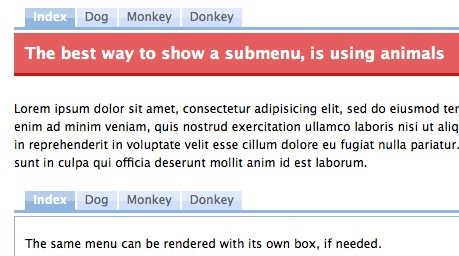-
Notifications
You must be signed in to change notification settings - Fork 39
Tabnav
The Tabnav widgets generates tabbed navigations. It can create horizontal, vertical, nested tabbed navigations.. and you can style it the way you want using CSS hooks.
It provides an easy way to pass highlighting rules and disable tabs at runtime as well.
Let’s generate a main tabbed navigation for our site (I’ll call it main, you can call it what you want)
$ script/generate tabnav main
create app/views/widgets
create app/views/widgets/_main_tabnav.rhtml
It creates a partial with the tabnav definition.
Now we can insert the tabnav wherever we want, I’ll put it in my app/views/layouts/application.html.erb.
<html>
<head>....</head>
<body>
<% tabnav :main do %>
....your contents goes here, like:
<%= yield %>
<% end %>
</body>
</html>
Now reload your pages, you should see a Tabbed navigation and one tab for each controller. Now you can edit the app/views/widgets/_main_tabnav.html.erb partial.
edit: app/view/widgets/_main_tabnav.html.erb
add_tab do |t|
t.named "name of tab"
t.links_to :controller => "orders" # could also be :controller => "orders", :action => "show"
end
The tabnav generates and inline its own CSS by default. I you want to customize it, you should:
- copy the generated CSS you find in the page containing the tabnav (in your browser right click/show HTML)
- paste it into your stylesheet file
- turn off the automatic CSS generation (see below)
edit: app/view/widgets/_main_tabnav.html.erb
change: render_tabnav :main, :generate_css => true do
into: render_tabnav :main, :generate_css => false do
Sometimes you do not have one tab per controller and want a tab to be highlighted on different conditions.
edit: app/view/widgets/_main_tabnav.html.erb
add: t.highlights_on :controller => "locations" to the relevant tab.
It is not mandatory to highlight by :controller or :action. The highlight_on method will match any request parameter, so that:
add_tab do |t|
t.named "Animals"
t.links_to :controller => "animals"
t.highlights_on :is_animal => "true"
end
Will highlight on:
- localhost:3000/animals _matches :controller => “animals” _
- localhost:3000/animals/index _matches :controller => “animals” _
- localhost:3000/dogs?is_animal=true matches :is_animal => true
- localhost:3000/search?name=corky&is_animal=true matches :is_animal => true
note: multiple t.highlights_on statements can be used within a single tab for more granular highlighting logic. eg:
add_tab do |t|
t.named "Animals"
t.links_to :controller => "organisms"
t.highlights_on :controller => "organisms", :action => "mammals"
t.highlights_on :controller => "organisms", :action => "reptiles"
end
edit: app/view/widgets/_main_tabnav.html.erb
change: t.links_to :controller => "orders"
to: t.links_to hash_for_orders_path
Example: You only want to show a tab if a user is logged in:
add_tab do |t|
t.named 'Software'
t.links_to :controller => "programs"
end if logged_in?
Create a new tabnav with a different name:
$ ruby script/generate tabnav invoices
Insert the following code in your relevant view file(s):
<%= tabnav :invoices %>
Example: You want a tab for every CRUD action:
edit: app/view/widgets/_invoices_tabnav.html.erb
add_tab do |t|
t.named "show"
t.links_to :controller => "invoices", :action => "show"
end
add_tab do |t|
t.named "new"
t.links_to :controller => "invoices", :action => "new"
end
add_tab do |t|
t.named "edit"
t.links_to :controller => "invoices", :action => "edit"
end
Note: remember to add highlighting rules to the main tabnav, to maintain highlighting.
